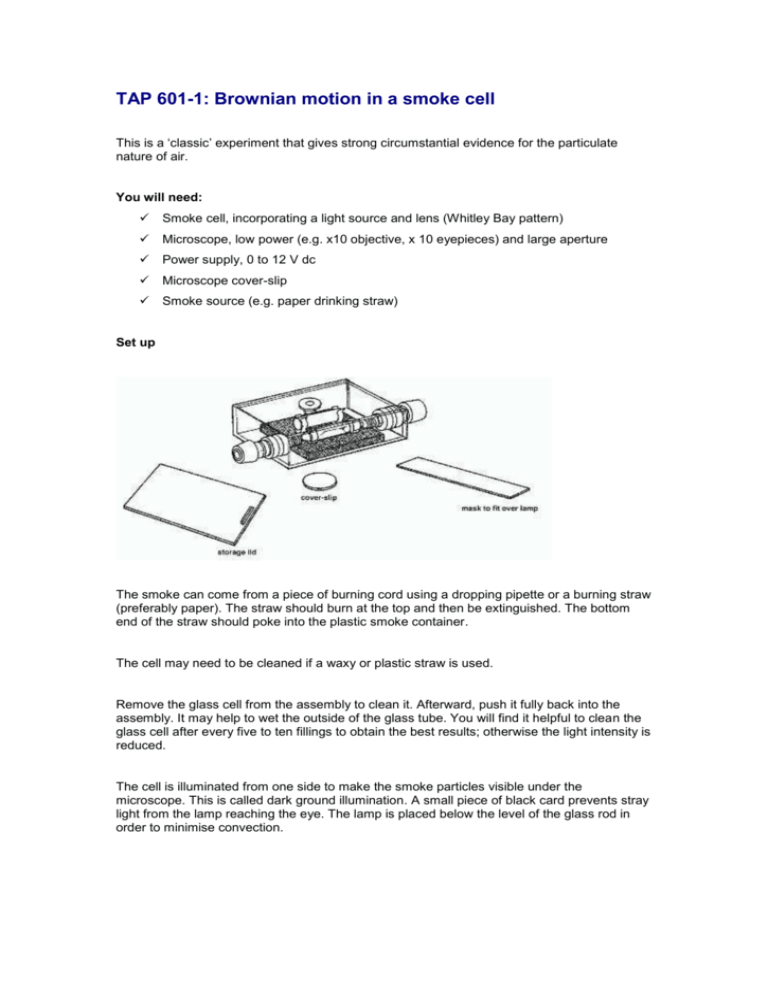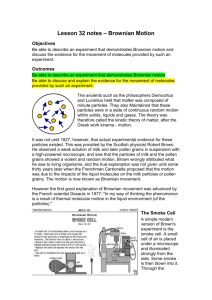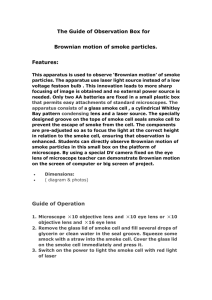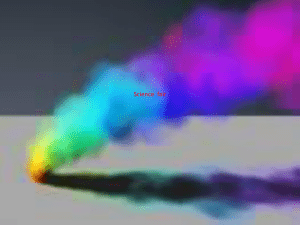Brownian Motion Experiment: Smoke Cell Guide
advertisement

TAP 601-1: Brownian motion in a smoke cell This is a ‘classic’ experiment that gives strong circumstantial evidence for the particulate nature of air. You will need: Smoke cell, incorporating a light source and lens (Whitley Bay pattern) Microscope, low power (e.g. x10 objective, x 10 eyepieces) and large aperture Power supply, 0 to 12 V dc Microscope cover-slip Smoke source (e.g. paper drinking straw) Set up The smoke can come from a piece of burning cord using a dropping pipette or a burning straw (preferably paper). The straw should burn at the top and then be extinguished. The bottom end of the straw should poke into the plastic smoke container. The cell may need to be cleaned if a waxy or plastic straw is used. Remove the glass cell from the assembly to clean it. Afterward, push it fully back into the assembly. It may help to wet the outside of the glass tube. You will find it helpful to clean the glass cell after every five to ten fillings to obtain the best results; otherwise the light intensity is reduced. The cell is illuminated from one side to make the smoke particles visible under the microscope. This is called dark ground illumination. A small piece of black card prevents stray light from the lamp reaching the eye. The lamp is placed below the level of the glass rod in order to minimise convection. What to do 1. Fill the cell with smoke using a dropping pipette and cover it with a glass cover-slip. This will reduce the rate of loss of smoke from the cell 2. Place the cell on the microscope stage, fit the mask and connect to a 12 V power supply. 3. Start with the objective lens of the microscope near the cover-slip. While looking through the microscope, slowly adjust the focus, moving the objective lens away from the cover-slip, until you see tiny dots of light. 4. Watch the particles carefully. Note what you see. Practical advice As this is such an important experiment - one of the few to show the 'graininess' of nature and to give strong support to the idea that gas molecules are in constant motion - students should be given plenty of time to set it up and see it clearly. We know what the students are supposed to see. They may not. Consequently, the students may not ‘see’ what we expect. We expect them to observe jiggling points of light. The vertical component of the motion causes the bright points to go out of focus and to disappear. This will not be obvious to every student. The points of light may also have a drift velocity but we know that this observation is unimportant. The students don’t know that the drift (due to large scale convection effects amongst other causes) is unimportant, and so this may become their major observation. A 'prepared' mind helps the scientist to see. Once the students ‘know’ what to look for, it is useful to repeat the experiment – they’ll see the expected effect second time around. The bright specks of light do not bounce into each other before changing direction. Why? Ask students to note down an explanation of the observations. Discuss what everyone thinks is going on and then describe (or elicit through questioning) the kinetic explanation – that smoke particles are observed as points of light, and their jiggling is due to collisions with much smaller and invisible air particles. Students should realise that an invisible movement explains an observed movement. It becomes somewhat circular when Brownian motion is (incorrectly) given as evidence of the particulate nature of air – it is circumstantial at best. "How big are air molecules?" "Well, smaller than the smallest specks of ash that makes up smoke!" This may lead to guesstimating. 1 mm across?, 0.1 mm?, 0.01 mm? Or even smaller? How many smoke particles could you park side by side along the edge of a postcard (15 cm long)? This is a chance to make an order of magnitude guess on whether they think that there would be 100, 1000, 10000, 100000, working in powers of 10. And now guess how many molecules you could park side by side on each smoke speck. How many is that along the edge of the postcard? Molecules must be very small indeed and atoms even smaller. Common sense tells us that. Alternative approaches If a camera is available for the microscope, you can demonstrate this experiment quickly to the whole class by following the camera instructions. However, ‘seeing for yourself’ has much to commend it in this case. Safety ! Teachers must ensure that light from the Sun is not reflected up through the microscope. (Once the cell is in position, the stage aperture is covered, removing the hazard.) Brownian motion: facts and myths Robert Brown is correctly referred to as having observed the jittering motion of small particles, but 1. he wasn't the first to record the observation, and 2. he did NOT observe the motion of actual pollen grains. How many text books etc continue to hand on these mistakes? The title of Browns paper was "A Brief Account of Microscopical Observations ... on the Particles CONTAINED in the Pollen of Plants". Pollen itself is too large (and hence has too much mass) to be small enough to be buffeted significantly by water molecules etc. [The most recent reference pointing this out: Nature, 10 March 2005 p 137] The first recorded observation of what we now call Brownian motion was made in 1785 by Jan Ingenhauz using charcoal dust. [Ref: Nature, 7 June 2001 p 641] Having used particles derived from living matter, Brown had to try several other inanimate substances to convince himself that the motion he observed was not something to do with a 'life force', but a property of all microscopic matter. This 'systematic investigation' is what won for Brown the accolade of having the jittering motion named after him, work that Ingenhauz didn't need to do. Today's research into nano technology now routinely fabricates nanoparticles. Controlling them suspended in liquids is quite a task. One method is to use a direct current controlled by a feedback system to cancel out the Brownian Motion. The position of the 20 nm polystyrene spheres is monitored by a fluorescence microscope and the voltage across the solution altered accordingly. So far nano-particles have been confined to within 1 micron. Alternatively, the path of the particle can be manipulated by suitable changes of the applied voltage. [Ref: Nature, 10 March 2005 p 156.] Even before the recent advent of nano-technology, Einstein's 1905 paper on Brownian Motion is his most cited paper (i.e. more than for Special Relativity or his work on photons). It is used by scientists working on such varied topics as aerosol particles ("pollution"), the properties of milk, paints, granular media (powders) and semiconductors. [Ref Nature, 20 January 2005 p 216] External references This activity is taken from http://www.practicalphysics.org ‘Brownian motion: facts and myths’ is taken from CAPT (Connecting Advancing Physics Teachers) email support by Rick Marshall.










